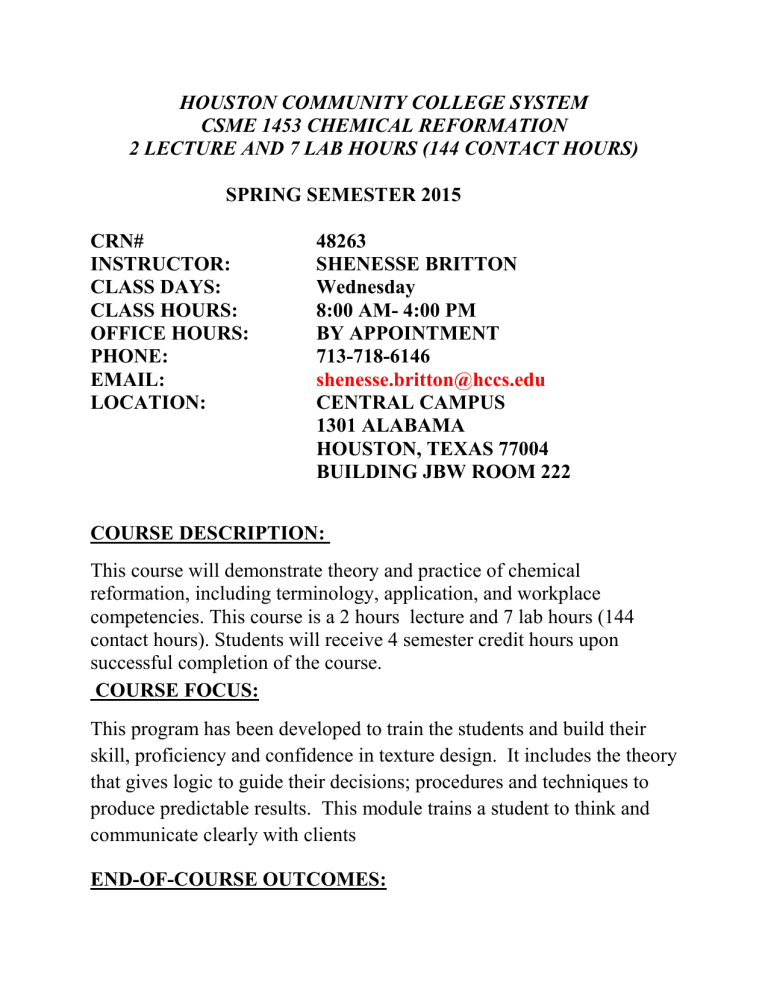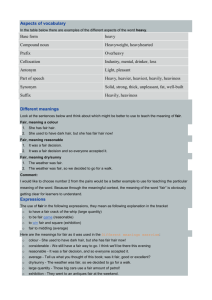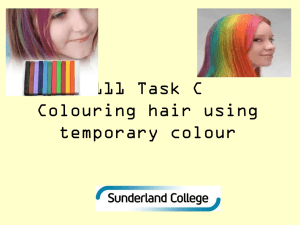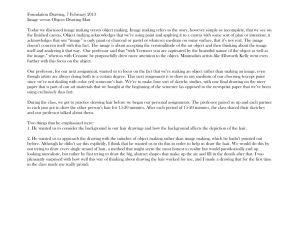1453 syllabus spring 2015

HOUSTON COMMUNITY COLLEGE SYSTEM
CSME 1453 CHEMICAL REFORMATION
2 LECTURE AND 7 LAB HOURS (144 CONTACT HOURS)
SPRING SEMESTER 2015
CRN# 48263
INSTRUCTOR: SHENESSE BRITTON
CLASS DAYS:
CLASS HOURS:
OFFICE HOURS:
Wednesday
8:00 AM- 4:00 PM
BY APPOINTMENT
PHONE:
EMAIL:
LOCATION:
713-718-6146 shenesse.britton@hccs.edu
CENTRAL CAMPUS
1301 ALABAMA
HOUSTON, TEXAS 77004
BUILDING JBW ROOM 222
COURSE DESCRIPTION:
This course will demonstrate theory and practice of chemical reformation, including terminology, application, and workplace competencies. This course is a 2 hours lecture and 7 lab hours (144 contact hours). Students will receive 4 semester credit hours upon successful completion of the course.
COURSE FOCUS:
This program has been developed to train the students and build their skill, proficiency and confidence in texture design. It includes the theory that gives logic to guide their decisions; procedures and techniques to produce predictable results. This module trains a student to think and communicate clearly with clients
END-OF-COURSE OUTCOMES:
Identify terminology related to chemical reformation; demonstrate the proper application and exhibit workplace competencies related to chemical reformation.
External accreditation standard is a passing score of 70% on state licensing examination administered by Texas Department of Licensing and Regulation on the first attempt.
ACADEMIC PREREQUISITES:
College ready reading
CO-REQUISITES:
LEAD 1200, CSME 1410 and CSME 1405
TEXT AND REFERENCES:
Milady Standard Cosmetology 2012 Edition Cengage Learning
ISBN13-:978-14390-5930-2
Cosmetologists Texas Occupations Code, Chapter 1602 &1603, and
16 Texas Administrative Code Chapter 83 and Texas Occupations Code,
Chapter 51 Texas Department of Licensing and Regulation, June 2006
Suggested Reference:
Hair Structure and Chemistry Simplified, Revised Edition, Author:
Douglas Schoon, Delmar Publishing
STUDENT LEARNING OUTCOMES:
Demonstrate the correct procedure to section, block, wrap and process the chemical wave projects assigned, observing all safety and sanitation guidelines and complete within the specified time frame, with a minimum score of 80%.
Identify and explain the processes, products, and chemicals used to relax overly curly hair, including safety precautions and product information, hair and scalp analysis and client records. The student must pass the theory portion of this unit with a minimum of 75% on the written examination.
Demonstrate the correct procedure for a chemical relaxer service on a model observing all safety and sanitation guidelines within an hour time frame with a minimum score of 80%.
DRESS CODE:
Students must be dressed professionally and appropriately in accordance with the TDLR rules and departmental regulations.
Students must wear a lab coat at all time and if not dressed in proper uniform will not be allowed to clock in.
LAB REQUIREMENTS:
Students enrolled in this course are expected to participate fully in and complete the lab exercises assigned to them. Students should have progress sheet documentation. They are to read and follow instructions carefully especially in relation to safety and sanitation precautions.
Failure to complete lab assignments will result in a reduction of semester grade.
STUDENT WITH DISABILITIES:
The Disability Support Services (DSS) Office assists students with physical, learning or emotional disabilities in developing independence and self-reliance. Services include adaptive equipment and reasonable accommodation for admissions assistance, testing, academic advising, and registration and classroom instruction.
Students with special needs or disabilities which may affect their ability to succeed in college classes or participate in college/programs/activities should contact the Disabilities Support Services (DDD) located at each college. Academic accommodations will be provided only after students
have properly registered for services through designated disability services staff.
The student is advised to contact the DSS office at least 60 days prior to the beginning of the term. See additional procedures outlined the HCCS
Student Handbook.
Disability support services can also be found online at these Web sites: http://www.rehab.state.tx.us
http://www.ican.com
MAKE-UP POLICY FOR MISSED ASSIGNMENTS OR TESTS:
There will be no make-up for missed unit exams. There will be no make-up for missed practical assignments Make-up for a missed mid-term or final test will be permitted only if the student informs the instructor in advance.
The student must make arrangements to take the missed test no later than 3 days after the original test date. It should be understood that the make-up test would not be the same as the test given to the rest of the student body.
SCHOLASTIC DISHONETY AND CLASSROOM CONDUCT:
Students are expected to conduct themselves with honor and integrity in fulfilling the course requirements. Any student found cheating on a test, plagiarizing or in collusion will receive an "F" for the assignment and the course and will be dropped from the program.
This level of development in a students' training is crucial to their professional development and success; any student that is disruptive or disrespectful will be dismissed from the program. Students on the client floor are expected to conduct themselves in a professional manner. Loud boisterous conduct or refusing to serve a client will constitute grounds for dismissal from the program. See student handbook for college policy on academic dishonesty and disciplinary problems.
ATTENDENCE AND WITHDRAWAL POLICIES:
Students are expected to attend class daily and be on time. Any students absent from class for more than 4 days will be dropped from the program. Students arriving late to class will not be allowed to clock in.
Administrative drops are at the discretion of the instructor. It is the responsibility of the student to withdraw from the program to keep from receiving an "FX" for the class.
COURSE COMPETENCIES:
Upon successful completion of the course the student will be able to exhibit the following competencies:
A.
Understand and exhibit the ability and speed to wrap and process a perm.
B.
Master the theory, concepts and terminology utilized in the practice of the cosmetology profession.
C.
Identify the various types of chemical hair relaxer and describe application.
D.
Develop and demonstrate appropriate wrapping techniques.
E.
Identify and apply safe working practices to all training situations.
F.
Apply permanent wave solutions to normal, bleached and problem hair.
G.
Maintain records of materials and results obtained in client services.
PERFORMANCE OBJECTIVES:
A.
Student will wrap a block perm, and process the chemical wave in accordance with instructions and guidelines.
B.
Given instruction and guidance by instructor student will identify the process and chemicals used to relax over curly hair and complete a soft curl service.
C.
Given the guidelines for student conduct and expected behavior delineated in the student handbook, the student will conduct him or
herself in a manner appropriate to a college setting and conducive to effective teamwork, in compliance to course competencies F, G and H. Performance will be satisfactory if the student displays the maturity, cooperation and teamwork necessary to complete a group project assignment.
COURSE CONTENT:
A.
9 section blocking procedures.
B.
Structure of hair
C.
Chemistry of hair
D.
Product Knowledge
E.
Curl reformation chemicals and the use of chemicals
F.
Safety and sanitation
ASSESSMENT OF STUDENT COMPETENCIES:
A. Practical examination
B. Written Examinations
C. Weekly progress achievement charts
D. Individual or group class projects
E. Situational observation by instructor (i.e. attendance, ethics conduct, and attitudes).
GRADE DETERMINATION:
Unit Exams/Skill Objectives 25%
Mid Semester Exam 25%
Attendance
Final Exam
25%
25%
GRADING POLICY:
A (90-99/Excellent)
B (80-89/Good)
C (70-79/Fair)
D (60-69/Passing)
F (Failing)
IP (In Progress)
W (Withdrawn)
I (Incomplete)
CSME 1453 COURSE CALENDAR:
Week 1 Orientation / Rules and Regulations
2&3 Ch.12 Basics of Chemistry
Matter
Lab: Basic Parting Techniques and
Rod Placement
4&5 Ch.12 Basics of Chemistry Lab: Basic Permanent Wrap (p.631)
Potential Hydrogen (pH)
6 Ch.20 Chemical Texture Services
The Structure of Hair Lab: Basic Permanent Wrap (p. 631)
7 Review for MID-TERM EXAM
8 MID-TERM EXAM
9 Ch.20 Chemical Texture Services) Permanent Waving
Lab: Curvature Permanent Wrap (p. 635)
10 Ch.20 Chemical Texture Services
Permanent Waving Lab: Bricklay Permanent Wrap (p. 638)
Permanent Wave Using a Weave
Technique (p.640)
11 Ch.20 Chemical Texture Services
Chemical Hair Relaxers Lab: Permanent Wave Using a Piggyback
Technique (p.642)
Permanent Wave Using a Spiral Wrap
Technique (p.644)
12 Ch.20 Chemical Texture Services
Chemical Hair Relaxers Lab: Applying Thio Relaxer to Virgin
Hair (p.647)
13 Ch.20 Chemical Texture Services
Curl Re-Forming Lab: Applying Hydroxide Relaxer to
Virgin Hair (p.653)
14 Ch.20 Chemical Texture Services
Curl Re-Forming Lab: Curl Re-Forming (Soft Curl
Perm)
(p. 659)
15 REVIEW FOR FINAL EXAM
16 FINAL EXAM
Houston Community College Cosmetology Program
Chemical Reformation and Related Theory CSME 1453
Student Name: __________________________________ Permit
Number:______________
Assessments
GRADE
Module
Completion
Date
Orientation, State Rules, Regulations
Career Information, State Laws & Regulations, Safety and
Sanitation, client protection
Permanent Waving Essentials a.
Perm Theory b.
Perming Essentials c.
Client Consultation
Basic Perming
Demonstrate the correct procedure to section, block, wrap and process the chemical wave projects assigned, observing all safety and sanitation guidelines and complete within the specified time frame
Advanced Perming
Demonstrate proficiency in performing zonal and freeform perm patterns.
Basic Relaxing
Identify and explain the processes, products, and chemicals used to relax overly curly hair a.
Demonstrate both a virgin and retouch thio relaxer service. b.
Demonstrate both a virgin and retouch sodium hydroxide relaxer service.
Advanced Relaxing
Demonstrate the ability to perform both a virgin and a retouch curl reformation service
Instructor Comments
Instructor Signature: ______________________________________








